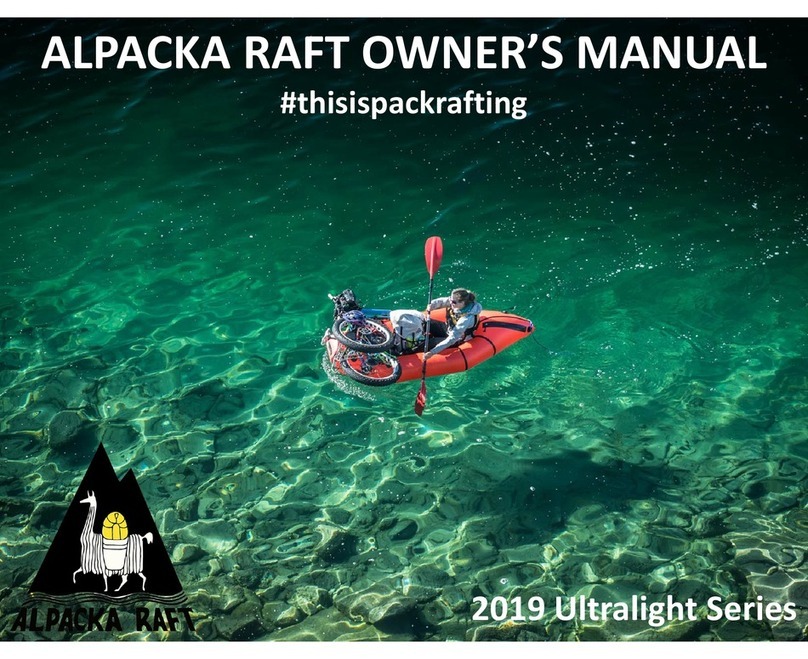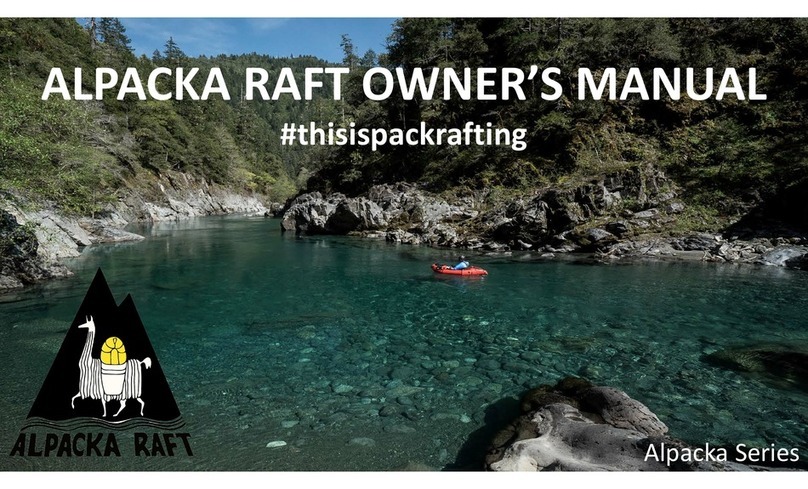GNU BASIC SETUP
7
Seating Systems Setup –The Gnu can be configured with either a C2 style seat that
allows the paddlers to kneel on either side like awhitewater C2 style canoe or a
Touring Seat that allows the paddling either from a kneeling position or asitting
position like aclassic touring canoe.The C2 Seat provides a lower center of gravity
and much better control in moving water than the Touring Seat, while the Touring
Seat offers better comfort for long days on the water.Specific Seat setup
instructions are provided on the following pages.
Inflating –The Gnu features a lightweight single valve allows high pressure oral
inflation and quick deflation with a quick twist of the valve core. Turning the valve
core to the right will open the valve for deflation and turning the core to the left
will allow the one-way flap to engage for tempering. To inflate, insert the valve
adapter on the inflation bag into the valve and twist to the right to lock in place.
Use the inflation bag to capture air and compress it through the valve (see the
inflation bag video on our website for more details). As the boat fills up, you may
want to turn the valve core to the left (without disengaging the adapter) to close
the one way flap which will allow you to get more air in with the inflation bag.
When the boat is full, disconnect the valve adapter and proceed to tempering.
Tempering –Unlike a spring valve used in larger rafts, our valve is designed with a
very light action 1-way flap to allow the boat to be orally tempered. Note that the
light action 1-way flap will not engage until you have orally added some pressure
to the raft.The amount of air pressure that you choose to use is personal, but we
recommend approximately 1.2-2.0 psi which is the max that anormal person can
orally add into the boat. Be careful not to exceed 2.0psi if you are using a pump.
After tempering, screw on the valve cap to prevent any leakage while boating.
NOTE –LEAVING YOUR ALPACKA RAFT IN THE SUN UNATTENDED CAN CAUSE
THE AIR PRESSURE IN THE CHAMBER TO RAPIDLY RISE, WHICH CAN LEAD TO
FAILURE OR PERMANENT DAMAGE.ALWAYS LET SOME AIR OUT YOUR BOAT AND
SEATS BEFORE TAKING ABREAK FROM THE WATER IN THE SUN.
Deflating –To deflate, remove the valve cap and twist the valve core to the right.
Roll the boat from the bow to remove additional air. During the valve break in
period, you may need to hold the valve open (turned to the right) during
deflation.If you have aCargo Fly, once the packraft has been de-tempered with
the valve you can open the Cargo Fly zipper to release the rest of the air.
Folding/Rolling –There is no right or wrong way to roll or fold your boat for
transport. Do whatever fits best for your use and carrying method.We
recommend the following ways:
•For awide thinner roll, fold in half lengthwise and roll from the bow.;
•For a narrower thicker roll, fold into thirds lengthwise and roll from the bow;
•For arelatively square fold, try folding into quarters lengthwise and then
folding in 1-foot length sections from the bow and secure with astrap.
•Removing the seat from the Gnu and carrying as two packages will reduce the
packed size.
NOTE –One of the most important considerations in using your packraft is the
way it feels to you –how comfortably it fits and how easy it is to enter and exit.
Do not overtighten your thigh straps and backband as it could impair your ability
to exit the boat.





























